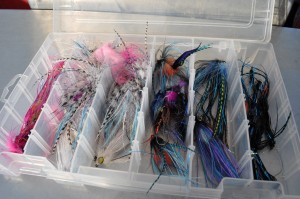“What pattern should I use?” is the number one question I hear out on the river. To be honest this is the least important peace of information I can provide.
I am sure a number of you that have fished with me are now scratching your heads. “But didn’t he refuse to let me use my own flies? Didn’t he insist I use that stupid black and blue thing?”. Yes, I am very fussy about my flies but it has little to do with material or pattern and more to do with the confidence that comes from knowing how the fly has been tied and how it is going to fish.
When I first started guiding, I let my more experienced clients use there own flies. Though there was a wide variety to these selections, I began to see a number of common traits.
In this article, I hope to lay out some of these similarities and explain how I have incorporated them into my own patterns.
This article comes with a disclaimer. All concepts and theories about steelheading are hard to prove. Fly selection is one of the hardest. I am adamant in my methods but much of what I say is at best, an educated guess.
Weight:
The first similarity that I observed in the boxes of experienced anglers is a marked variety in weights. Some have taken this to the extreme, with dozens of classes.
To make life simple I use three distinct varieties. When I choose a pattern, I tie it first in an un-weighted version, then with ten wraps of .030 lead and finally with twenty wraps. I make sure to keep the patterns identical, except for a change in thread to mark the different classes. It is a good idea to have at least three patterns of each class.
I may use dumb bell eyes but I like to keep the approximate weight variation the same.
Why is weight so important? Don’t we fish tips to achieve depth? Of course, but in any given run the depth of the river can change. It takes only moments to switch out a fly. Changing a head takes much longer. While the angler with only one weight struggles with snags, dinged hooks and the time consuming fumble to change heads, the angler with a variety, has switched out flies and is covering water.
The second reason for weighted flies is a little more complicated. In some runs, the bead of a river has pronounced dips and holes. With a long tip, (standard 15ft range) the line skirts the edges of these indentations, never taking the fly down quite far enough. A weighted fly or a short fast sinking head (five to eight foot T14 + short leader) can be more productive when covering runs that have these so-called holes.
Size:
The second thing I notice was that experienced anglers will tie the same pattern in a variety of sizes. Once again, I have simplified this to three basic classes: the swimming monsters (flies in the 4 to 6 inch range); the mediums (2 – 3.5 inches); and the babies (2 inches and below.)
Size plays a very important role when changing styles to suit conditions.
Clarity:
When water clarity drops, I like to use larger flies. With three feet of visibility (when I can just barely see my boots, I fish medium sizes. When visibility becomes less than two feet, I bring out the monsters. A few fish may want to jump out of the water when they see these creations but at least I know they have taken notice.
Temperature:
Many disagree with me on this, but when temperatures become cold (53 degrees celsius and below) I tend to use smaller flies. My theory is that the fish have limited energy and the prospect of chasing down a large fly is less appealing than a smaller easily caught presentation.
At least in regards to the Bulkely I will entertain and defend any debate on this subject…Please bring a bottle of red wine or a good single malt to make things interesting.
One last note on size. A good friend and colleague taught me a valuable lesson one season. He was fishing with two clients (good friends of mine). I will leave out their names but they are ‘Vacuum Cleaners,’ in their own right.
They also enjoy letting the guide fish behind them when they work through a run. My friend noticed that they were using flies that fall in the monstrous category. He decided his only hope was to show the fish something different. He switched to a baby woolly worm, size 8.
At the end of the week, you should have heard the stories from his clients. “That stupid little worm will be the death of me,” said one. My friend did not out fish them but he kept up in numbers, taking fish that their larger flies had passed over.
I touched on this in the article about how to deal with a player. The woolly worm has become one of my favorite ‘close out flies’ but the concept is not reserved for enticing a steelhead to a second take.
If you end up fishing behind two or more anglers, or know that a piece of water has been worked over, try switching to something that the fish have not seen before. A good rule of thumb is to assume the other anglers are using medium to large flies, so go small.
Shoulders and Movement:
The final similarity I observe in the boxes of experienced anglers is that all the patterns, no matter how varied in material, color, size or weight, all had two things in common. They had movement in the water and one standard silhouette.
Movement:
Movement is simple to achieve, marabou, some synthetics, rabbit, ostrich hurrel, rhea, and buck tail, (there are many more) move well in the water. They breathe with the current and mimic how a small minnow, ditch eel or leech might “swim” through the water. Take advantage of these materials and avoid materials that do not move (Many synthetics, heavy crystal flash, ect.).
Silhouette:
This is probably my most adamant recommendation. The steelhead may not have time to see color, style, or material but he will see the silhouette. Look to the standard shapes in nature to be your guide. Salmon fry, leaches and eels along with 90% percent of what they have fed on in the oceans all have a somewhat teardrop shape contour (not only on the horizontal but from a vertical plane as well). The word I use is “shoulders”.
The head should be bulky, and then taper off to a point…. box tails are not natural! There’s nothing I hate more than a beautifully tied fly that looks great on the vice only to place it in the water and find that it looks like a flying shoebox. Test your flies (both the ones you tie and ones purchased) – even if you only take them to the sink and run water over them – if the tail looks like a box, change the way you tie in the material to taper the silhouette into a point.
Finally, here is the recipe for my ‘stupid’ Bulkley Black and Blue – the fly I use about 70% of the time.
Just click on the link below from the previous blog entry:
Other colors I like: maroon and black/ maroon black blue / solid black / blue and white – I also tie them all as a ‘bastard’ egg sucking leach. Simply add wraps of peach chenille to the head.
I hope these simple concepts will help guide you when you are filling your box for next season. Give the shop a call (604-872-2204) if you have any questions or would like a hand tying your steelhead flies.
Tight lines,
Matt





